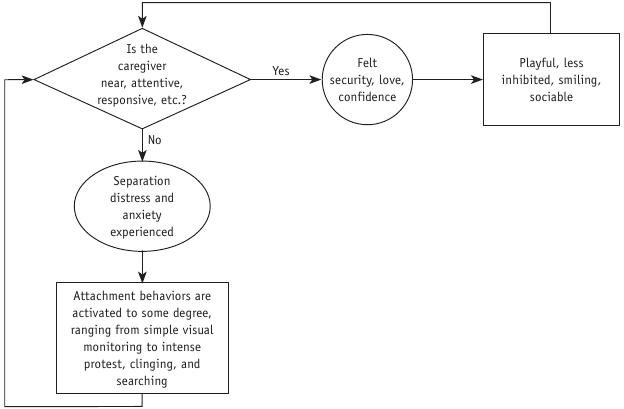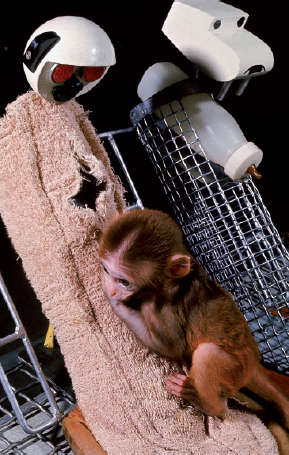Patricia Lyu, Attachment: Someone to Watch over You
| Patricia Lyu | Attachment: Someone to Watch over You |
To learn about how Patricia Lyu used sources to support her own ideas, turn to A Writer at Work. How did she contextualize sources to show their relevance? How did she combine summary and quotation to integrate source material into her essay and avoid simply stringing quotations together?
ORIGINALLY, Patricia Lyu wrote this essay explaining the concept of infant attachment for her composition course. You will see that following her instructor’s recommendation, Lyu chose a concept she had learned about in another course, Introduction to Psychology, and she quotes from that course’s textbook. She also uses a number of other sources, including articles and books, some of which she accessed through the library’s Web site and others that she found in print in the library. As you read, consider the following questions as well as those in the margin:
- How effectively does Lyu integrate source material into her own sentences?
- What strategies does she use to cite her sources? Why do you think citing sources this way is expected in most college papers?
Basic Features
A Focused Explanation
A Clear, Logical Organization
Appropriate Explanatory Strategies
Smooth Integration of Sources
“Babies are such nice ways to start people.”
—Don Herrold
1Fortunately, most people agree with humorist Don Herrold, because infants depend for their well-being, indeed for their very survival, on the goodwill of others. Developmental psychologists have wondered about the bond that needs to form between newborns and caregivers in order for infants to survive and thrive. How does that bond develop and how does it affect romantic relationships later in life? John Bowlby and Mary Ainsworth’s theory of attachment answers both of these questions.
Question
[Answer Question]
2Bowlby theorized that humans have evolved in ways that made infants and caretakers “biologically predisposed” to send and receive signals (“attachment behaviors” such as crying, smiling, and cooing) that bring the child into close contact with the caretaker, which assures the child’s safety, feeding, and likelihood of surviving to reproductive age (Cassidy 4–5). According to psychology professor R. Chris Fraley’s “A Brief Overview of Adult Attachment Theory and Research,” children develop what Bowlby called an “attachment behavioral system.” This system ensures that the attachment object (usually a parent or primary caregiver) will be physically present and attentive to the child’s needs. But attachment does not end in childhood. As Bowlby famously stated, it continues to play an important role throughout life, from “the cradle to the grave” (qtd. in Fraley 3). Attachment begins in need and is intensified by fear. As we will see, Tim O’Brien’s character Henry Dobbins in The Things They Carried provides a fascinating example of how the trauma of war affects adult attachment behavior and may even help explain religious faith.
3Bowlby’s understanding of attachment came from observations after World War II of children separated from parents or other primary caregivers. He saw that “separation anxiety”—being physically apart from the caregiver or perceiving the “threat” of separation—“activates the attachment system” (Kobak and Madsen 30). In his “Overview,” Fraley describes the way the attachment system works and also illustrates it with the flowchart shown in fig. 1:
the attachment system essentially “asks” the following fundamental question: “Is the attachment figure nearby, accessible, and attentive?” If the child perceives the answer to this question to be “yes,” he or she feels loved, secure, and confident, and, behaviorally, is likely to explore his or her environment, play with others, and be sociable. If, however, the child perceives the answer to this question to be “no,” the child experiences anxiety and, behaviorally, is likely to exhibit attachment behaviors ranging from simple visual searching on the low extreme to active following and vocal signaling on the other (1–2).
Question
[Answer Question]

Question
[Answer Question]
4Developmental psychologist Mary Ainsworth “contributed the concept of the attachment figure as a secure base from which an infant can explore the world” (Bretherton 759). She also designed a series of experiments using “the strange situation” in which researchers watched twelve- to twenty-month-old children through a one-way mirror as they played in an unfamiliar laboratory playroom, first while their attachment figure was with them and then as the caregiver stepped out of the room for a few moments. From this research, Ainsworth identified three basic types of attachment that children form with their primary caregiver: secure, anxious (or anxious-resistant), and avoidant (Fraley 4).
Question
[Answer Question]
5The secure child cries when the caregiver but goes to the caregiver and calms down when he or she returns. According to Ainsworth, these children feel secure because their primary caregiver has been reliably responsive to their needs over the course of their short lives.
6Ainsworth classifies the other two styles of attachment as insecure compared to the first attachment style. Anxious children may be clingy, get very upset when the caregiver leaves, and seem afraid of the stranger. They do not calm down when the caregiver returns, crying inconsolably and seeming very mad at the caregiver. Avoidant children ignore the caregiver when he or she returns. They seem emotionally distant and may even move away from him or her to play with toys.
7Attachment theory was revolutionary: “Before widespread acceptance of Bowlby’s theory, psychologists viewed attachment as a secondary drive, derived from primary drives like hunger” (“Attachment” 1). Harry Harlow’s primate research lent support to attachment theory, showing that infant monkeys bond to whatever is soft and cuddly. A psychologist at the Primate Laboratory at the University of Wisconsin, Harlow conducted a series of famous and rather disturbing experiments with infant monkeys. The infant monkeys were separated from their biological mothers and raised by a surrogate mother made of wood and covered with terry cloth or made from uncovered heavy wire (see fig. 2). Kimble, Garmezy, and Zigler, in their introductory psychology textbook, describe Harlow’s research this way:
Question
[Answer Question]
In one experiment, both types of surrogates were present in the cage, but only one was equipped with a nipple from which the infant could nurse. Some infants received nourishment from the wire mother, and others were fed from the cloth mother. Even when the wire mother was the source of nourishment, the infant monkey spent a greater amount of time clinging to the cloth surrogate. (21)
8Thus, Harlow’s research validated attachment theory by showing that the infant monkeys attached themselves to the more cuddly terry cloth “surrogate” even if it did not have a bottle and therefore could not feed them. Harlow demonstrated that attachment, the need for closeness and comfort, is as strong as the need for food.
9In other experiments, he also showed that fear is a strong motivator of attachment, leading the infant monkeys to seek consolation from the surrogate. In these experiments, Harlow put a strange object in the cage. If the surrogate was absent or if only the wire surrogate was present, the baby monkey would be afraid, often crying, sucking its thumb, and hiding in the corner. But if the terry cloth surrogate was present, the monkey would run to it, cling for a while, and then, apparently reassured, venture out again to explore the cage and confront the intruder. The conclusion drawn from this research is that the attachment figure provides security, especially in times of fear.

10The original research on attachment, plus Harlow’s monkey experiments, underlines the idea that “the attachment and fear systems are intertwined” (Cassidy 8). During a time of war, fear obviously is intensified, especially for soldiers in harm’s way. Therefore, we can see how applying the concept of attachment to The Things They Carried can be illuminating. It is especially helpful in understanding Henry Dobbins’s peculiar habit of wearing “his girlfriend’s pantyhose around his neck before heading out on ambush” (O’Brien 117). Fear triggers Dobbins’s attachment behavior. Like Harlow’s monkey, he seeks comfort from his attachment figure.
Question
[Answer Question]
11As an adult, however, Dobbins’s attachment figure is the object of his romantic love, his girlfriend. The association between infant attachment and adult relationships was first investigated in Cindy Hazan and Phillip Shaver’s appropriately titled breakthrough study, “Romantic Love Conceptualized as an Attachment Process.” Since then, attachment theory “has become one of the major frameworks for the study of romantic relationships” (Fraley and Shaver 132). This expansion of the concept of attachment should be no surprise given that Bowlby himself described the formation of attachment as “falling in love” (qtd. in Cassidy 5).
12Moreover, O’Brien’s description of Dobbins’s behavior shows that for adults under extreme duress, the attachment process includes the use of substitutes. For Dobbins, in the absence of his girlfriend, her stockings serve as a substitute attachment object, Dobbins’s security blanket: “He sometimes slept with the stockings up against his face, the way an infant sleeps with a flannel blanket, secure and peaceful. More than anything, though, the stockings were a talisman for him. They kept him safe.” (117–18)
Question
[Answer Question]
O’Brien makes the further point that the power of the security object comes from Dobbins’s unwavering faith in it: “he believed firmly and absolutely in the protective power of the stockings. They were like body armor” (118). Even after his girlfriend abandons him, Dobbins’s faith is not shaken because the object itself had taken her place in his attachment system. Dobbins clearly has a very secure attachment style.
13Through Dobbins’s example, we can see that O’Brien appears to be making a connection between having absolute confidence in one’s attachment figure and having strong religious beliefs. By calling the stockings Dobbins’s “talisman” and emphasizing their magical powers, O’Brien makes the connection explicit. Dobbins’s faith, in fact, is so strong that it seems to be contagious. The other soldiers somehow “came to appreciate the mystery of it” (118). Ultimately, we as readers also become invested in this belief system because, as O’Brien tells us: “Dobbins was invulnerable. Never wounded. Never a scratch” (118). The example of Henry Dobbins suggests that attachment is not only the evolutionary mechanism by which helpless infants survive, but it may also be a precursor to religious belief, the faith that someone is watching over you.
Question
[Answer Question]
Works Cited
Question
[Answer Question]
“Attachment.” Gale Encyclopedia of Psychology. Encyclopedia.com, 2001. Web. 5 Mar. 2012.
Bretherton, Inge. “The Origins of Attachment Theory: John Bowlby and Mary Ainsworth.” Developmental Psychology28 (1992): 759–75. Print.
Cassidy, Jude. “The Nature of the Child’s Ties.” Handbook of Attachment: Theory, Research, and Clinical Applications.Ed. Jude Cassidy and Phillip R. Shaver. 2nd ed. New York: Guilford, 2008. 3–22. Print.
Fraley, R. Chris. “A Brief Overview of Adult Attachment Theory and Research.” Dept. of Psychology. University of Illinois, 2010. Web. 5 Mar. 2012.
Question
[Answer Question]
Fraley, R. Chris, and Phillip R. Shaver. “Adult Romantic Attachment: Theoretical Developments, Emerging Controversies, and Unanswered Questions.” Review of General Psychology4.2 (2000): 132–54. PsycArticles. Web. 5 Mar. 2012.
Hazan, Cindy, and Phillip Shaver. “Romantic Love Conceptualized as an Attachment Process.” Journal of Personality and Social Psychology52.3 (1987): 511–24. PsycArticles. Web. 4 Mar. 2012.
Kimble, Gregory, Norman Garmezy, and Edward Zigler. Principles of General Psychology, 5th ed. New York: Wiley, 1980. Print.
Kobak, Roger, and Stephanie Madsen. “Disruptions in Attachment Bonds.” Handbook of Attachment: Theory, Research, and Clinical Applications.Ed. Jude Cassidy and Phillip R. Shaver. 2nd ed. New York: Guilford, 2008. 23–47. Print.
O’Brien, Tim. The Things They Carried. Boston: Houghton, 1990. Print.
Passman, Richard H. “Security Objects.” Gale Encyclopedia of Psychology. Encyclopedia.com, 2001. 5 Mar. 2012.